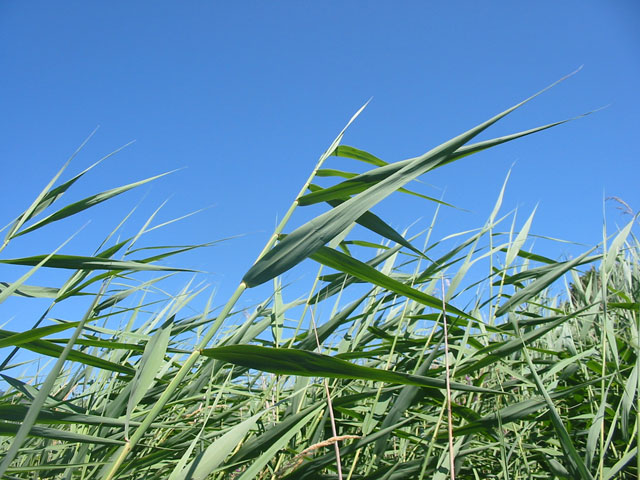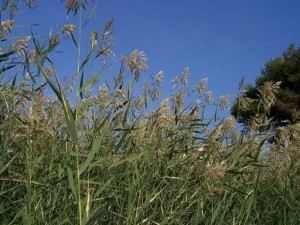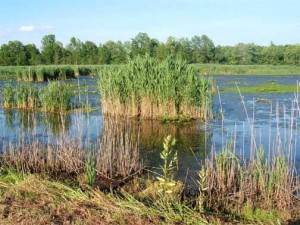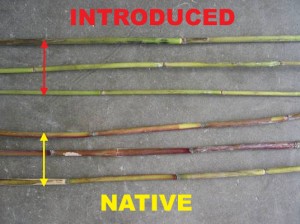Some 20 years ago I pondered upon the identity of what appeared to be a very tall grass in a former marlpit in Port Orange, a few miles south of Daytona beach. One would think there can’t be that many tall grasses locally but you would be surprised in a state with virtually thousands of non-native species. Further grasses can be maddening to identify, more so than mushrooms. They have a descriptive language all their own, the experts are few, and their books sometimes cost thousands of dollars. It took me three seasonal tries to get it right. First I thought an Arundaria, then an Arundo. I settled on Phragmites australis, the Common Reed, Wild Broomcorn… almost…
There’s one species — they think — and many varities, perhaps as many as 12 genetically different ones in the North America, eleven maybe native and one Eurasian. For me the question was Gulf Coast variety or Eurasian? Talk about a pain in the grass. Identifying it should have been easy. The Gulf Coast Common Reed has red stems where exposed to the sun —think sunburn — smooth stems, and a non-fuzzy blossom head that hangs to one side. The Eurasian Common Reed has green stems where exposed to the sun, lightly ribbed stems, and a fuzzy blossom head that goes out in all directions. Also the native tends to be yellow green and the non-native bluish green. I had three out of four. What an irritation but a change season produced the right fuzzy blossom. If it hadn’t I’d still be ignoring it. Even though the Gulf Coast Common Reed is native here my local one appears to be the non-native Eurasian Common Reed.
While the identification was difficult it turned out to be a good find because the Common Reed, which ever variety, has many edible uses. It’s also been around a long time, say the experts. They found evidence of it in 40,000 year old sloth dung… (Now there’s an occupation for cocktail party chitchat…) Besides sloths humans have eaten it for a long time as well. Just about every where it grows the plant has been used and consumed. Indeed, it is perhaps more versatile than cattails. The Common Reed has been harvested for building housing, thatching rooves, making boats, fire drills, flutes, splints, pen tips, weapons, hunting spears, arrows, rope, snares, mats, baskets, prayer sticks, jewelry, smoking implements, clothing, medicine, and food as well as sugar and salt. Boys of all ages used mesquite (Prosopis spp.) spines attached to common reed stems to catch small fish and crabs. It can also be used to clean heavy metals and sewage out of contaminated water.
As mentioned the Common Reed is Phragmites australis (frag-MY-tees oss-STRAY-less) which means “screen” and “south” or southern screen. It’s one of the most common flowering plants on the planet and is found throughout North America, Europe, Asia, Africa, America and Australia. In fact it is found on all continents except Antarctica. Hasn’t made its way to Alaska yet nor I think the Yukon and Nunavut. Usually a stand of Common Reeds are all clones. Each separate clone reed can live from five to eight years. The clone itself may reach a 1,000 years old. A stand provides shelter for various creatures but is not a major food source for any.
Green Deane’s “Itemized” Plant Profile: Common Reed
IDENTIFICATION: Phragmites australis: FloridaGrasses.org says it better than I: Enormous cane often seen rising with a plumose inflorescence from wet ditches. Ligule small (1 mm vs. > 2 mm in Saccharum). Leaf blades not auriculate (as opposed to Arundo and Hymenachne) and without the light basal coloration characteristic of Arundo. Spikelets unawned (vs. Saccharum giganteum). Internodes pubescent (vs. glabrous in Neyraudia) and lemmas glabrous (vs. pubescent in Neyraudia). Plants of Phragmites are similar in overall appearance to Arundo, but the latter has subequal glumes, a glabrous rachilla, and hairy lemmas. Vegetatively, plants of Arundo, but not those of Phragmites, have a wedge-shaped, light to dark brown area at the base of the blades. They also tend to have thicker rhizomes, thicker and taller culms, and wider leaves than Phragmites, but there is some overlap. Phragmites is much more widely distributed than Arundo in North America.
Not so easy to read. Here’s one from the US Forest Service: Common reed produces stout, erect, hollow aerial stems. Stems are usually leafy, persistent, and without branches. At the base, stem thickness measures 5 to 15 mm. Leaves are aligned on one side of the stem, flat at maturity, and measure 4 to 20 inches (10-60 cm) long and 0.4 to 2 inches (1-6 cm) wide. Leaf margins are somewhat rough, and leaves are generally deciduous. Common reed flowers occur in a large, feathery, 6- to 20-inch (15-50 cm) long panicle. The panicle has many branches and is densely flowered. Panicles are up to 8 inches (20 cm) wide after anthesis. Spikelets contain 1 to 10 florets. Floret size decreases from the base of the panicle upward. Lower florets are staminate or sterile and without awns. Upper florets are pistillate or perfect with awns. Occasionally all spikelets are abortive. Sometimes spikelets are reduced to a single glume and floret, causing panicles to lose their feathery appearance. Seeds are small, measuring up to 1.5 mm long.
“Rhizomes are thick, “deep seated”, and scaly and can grow to 70 feet (20 m) long. Rhizomes may grow 16 inches (40 cm)/year and live 2 to 3 years. Rhizomes in soil are commonly long, thick, and unbranched. In water, rhizomes are more slender, produce multiple branches, and are often shorter.” The roots can be eight inches to 30 feet deep.
Locally the one reed we would confuse it with is Arundo donax. Arundos have auricles and a light to dark brown wedge shape at the base of the leaf. Phragmites do not. Said another way. When the Phragmites leaf leans out from the stem the transition is smooth, well tailored. When the Arundo leave leans out there’s a wrinkle or extra growth beside or around the main stem.
TIME OF YEAR: Varies greatly. Year round in warm climates, season in northern climes, flowers from early to mid-summer into early or late fall. Seeds, shed in the winter, can float in water up to 124 days.
ENVIRONMENT: Wet areas, ditches, roadsides, median strips, railroad tracks, marshes, river banks, lake shores, tidal wetlands. The reed can grow 1.6 inches a day.
METHOD OF PREPARATION: From Cornucopia II, page 178: Young shoots are eaten like bamboo sprouts [read cooked] or pickled. Dried stems were made into a marshmallow-like confections by North American Indians. In Japan, the young leaves are dried, ground, and mixed with cereal flour to make dumplings. The partly unfolded leaves can be eaten as a potherb. A sugary gum that exudes from the stem is rilled into balls and eaten as a swewet. The rhizomes are sometimes cooked like potatoes. Although difficult to remove from its hull, the grain is said to be very nutritious [ and high in fiber.]
The Paiute used common reed’s sugary sap to treat lung ailments. The Apache used its rhizomes to treat diarrhea, stomach troubles, earaches, and toothaches.
A very extensive report on said can be read here.






Hey deane are you familiar with elephant grass sorry I don’t know the real name but it looks very similar to the common reed but doesn’t necessarily grow in or near water. It plagues old lots and un kept ditches.one thing is fer sure you’ll know your in it cause it is covered in irritating hairs on its stem.it grows prolly ten to twelve feet tall and pretty much looks like giant grass, I’m sure its a”weed”cause you can’t kill it.any info or insight to its ediblity or use would be appreciated, I heard its introduced.but like I said you’ll know if you walk through it cause its over your head and you WILL be itching
in the article it states reed was once used to remove heavy metals and sewage….do you know how they did that?? did they pile up thatch and do a simple filter ?? im curious
Heavy metals are removed by planting the reed, then removing the forage. It works really well for this partly because the rhizomes grow so deeply. The invasive is extremely prolific – I have a stand in the swampy part of my property that I can’t destroy because I can’t mow it in the summer. I was looking for information on how to create flour out of the “seed” portion.
Can we use this grass for river banks protection and enhancement of eroded banks?
Down by the brackish bay marshes in NJ, this stuff covers many many acres! I’ve tried using it for edible bits now and then, but it takes quite a bit of time. On the other hand, for making mats of dried stems, it’s very useful and easy to gather in huge quantities.
It depends upon which species is being called a “reed.”
hello. my name it thurman. i am a 43 year old man who was raised on back woods servival tought partly by my father in the cinteral hills of kentucky and the rest of my life by self study. i have always been excited about natural foods and medicans. i have great knowlage in compairasant to most my age or younger. but a speck.compaired to you. i am always.looking for new ways of useing common weed as medican or food. i admire your vidios, thow i have litle time to attend sesstions becouse i am a singke father of three. tottle sevin childern. and non share my interset. except only in stories i tell. i wpuld be.so.honered if we could comunicate and shair k.knowlage. im sure you have quite a bit more then i and would love to learn from you. please contact me ag thurmanyoung@yahoo.com. and i shal give you my.number as so we.might communicate threw text or other. thank you for viewing my words. and God bless for all you teach
The Reed’s clean the water (treat sewage) by giving bacteria a substrate to live on. This is how many mechanical waste water treatment plants work. The bacteria are present everywhere, but the more surface area for them to attach to the more work they can do.
hey Green Dean, i have been finding a cane or reed that i cannot identify for the life of me. it strongly resembles native river cane but it is shorter and it flowers every year. the stalk is not covered in any sort of husk so i know it is not arundo donax but the flowers do strongly resemble it. it grows between 4 ft is some stands up to 8 ft in others. it looks like a small bamboo in every aspect except that it flowers every year. it only grows in or around bodies of water or wetlands. the leaves are nearly identical to bamboo. the rysome is very large, about 4-5 inches in diameter. it is an evergreen. do you have any ideas?
Plants For A Future lists Arundo donax as being edible. Do know this to be true? My research pulls up medicinal purposes of the rhizome, but no strong ties to culinary purposes.
The answer is I do not know. It is reported that all native North American grasses are edible. Arundo donax is imported. I do recall reading somewhere long ago that it has a bit of cyanide in the roots (but so does bamboo.) So I never looked more into it at the time.
Just a note re remedial use of the reeds – if you’re cleaning polluted streams, those toxins will be stored in the rhizome, and in the stem potentially. Don’t eat them in that case. The plants are extremely invasive, like spreading bamboo, so if you can contain them in a garden environment you should do so (though they spread by seed just as well). V interesting reading re culinary use – has anyone tried eating them boiled or pickled (and unpolluted)?
I grew up using the reed for harvesting avocado and mango fruits, I have fond memories of the plant, I have been longing to plant it in a portion of my garden and make a place for it. But interestingly someone told me sap from the reed is used to treat epilepsy. Go try it, you lose nothing, after all its edible!